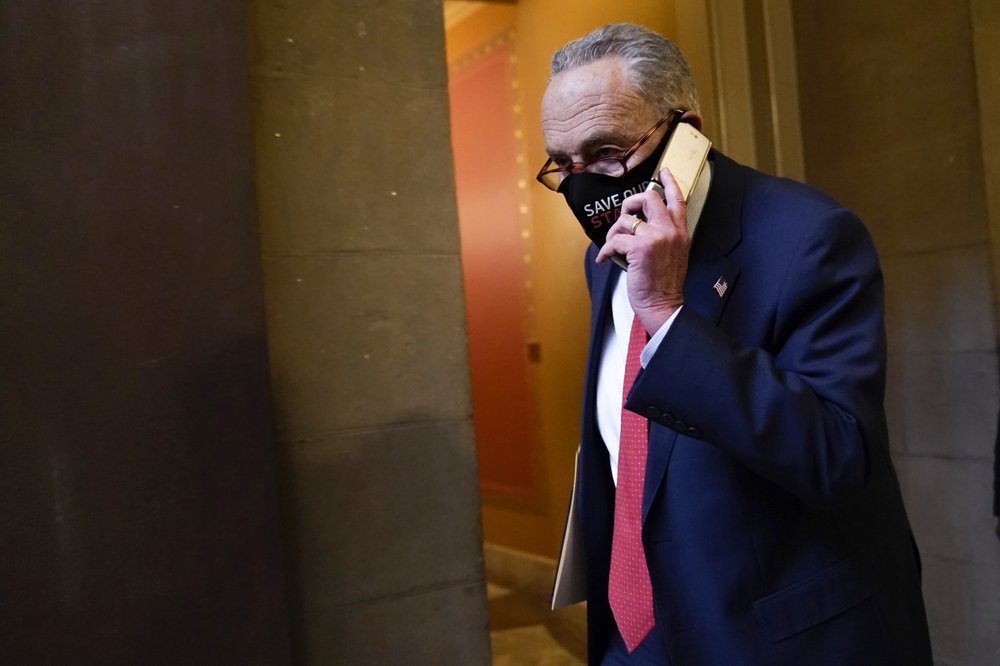
WASHINGTON (AP) — Top Capitol Hill negotiators sealed a deal Sunday on an almost $1 trillion COVID-19 economic relief package, finally delivering long-overdue help to businesses and individuals and providing money to deliver vaccines to a nation eager for them.
The agreement, announced by Senate leaders, would establish a temporary $300 per week supplemental jobless benefits and $600 direct stimulus payments to most Americans, along with a new round of subsidies for hard-hit businesses and money for schools, health care providers and renters facing eviction.
The House was expected to vote on the legislation on Monday, said a spokeswoman for House Majority Leader Steny Hoyer, D-Md. The House would pass a one-day stopgap spending bill to avert a government shutdown at midnight Sunday. The Senate was likely to vote on Monday, too. Lawmakers were eager to leave Washington and close out a tumultuous year.
The final agreement is the largest spending measure yet. It combines COVID-19 relief with a $1.4 trillion government-wide funding plan and lots of other unrelated measures on taxes, health, infrastructure and education.
While Schumer said Democrats would have wanted more,
Passage is nearing as coronavirus cases and deaths spike and evidence piles up that the economy is struggling.
Late-breaking decisions would limit the $300 per week bonus jobless benefits — one half the supplemental federal unemployment benefit provided under the CARES Act in March — to 10 weeks instead of 16 weeks as before. The direct $600 stimulus payment to most people is also half the March payment, subject to the same income limits in which an individual’s payment begins to phase out after $75,000.
President Donald Trump is supportive, particularly of the push for providing more direct payments. “GET IT DONE,” he said in a tweet late Saturday.
It would be the first significant legislative response to the pandemic since the $1.8 trillion CARES Act passed virtually unanimously in March.
A breakthrough came late Saturday in a fight over Federal Reserve emergency powers that was resolved by the Senate’s top Democrat, Chuck Schumer of New York, and conservative Republican Pat Toomey of Pennsylvania. That led to a final round of negotiations on other issues.
Lawmakers had hoped to pass the bill this weekend and avoid the need for a stopgap spending bill, but progress slowed Saturday as Toomey pressed for the inclusion of a provision to close down the Fed’s lending facilities. Democrats and the White House said it was too broadly worded and would have tied the hands of the incoming Biden administration, but Republicans rallied to Toomey’s position.
Late-breaking decisions would limit $300 per week bonus jobless benefits — one half the supplemental federal unemployment benefit provided under the CARES Act in March — to 10 weeks instead of 16 weeks as before. The direct $600 stimulus payment to most people would be half the March payment, subject to the same income limits in which an individual’s payment begins to phase out after $75,000.
After the announcement, Schumer and House Speaker Nancy Pelosi, D-Calif., announced additional details, including $25 billion in rental assistance, $15 billion for theaters and other live venues, $82 billion for local schools, colleges and universities, and $10 billion for child care.
The governmentwide appropriations bill would fund agencies through next September. That measure was likely to provide a last $1.4 billion installment for Trump’s U.S.-Mexico border wall as a condition of winning his signature.
The bill was an engine to carry much of Capitol Hill’s unfinished business, including an almost 400-page water resources bill that targets $10 billion for 46 Army Corps of Engineers flood control, environmental and coastal protection projects. Another addition would extend a batch of soon-to-expire tax breaks, including one for craft brewers, wineries and distillers.
The end-of-session rush also promised relief for victims of shockingly steep surprise medical bills, a phenomenon that often occurs when providers drop out of insurance company networks.